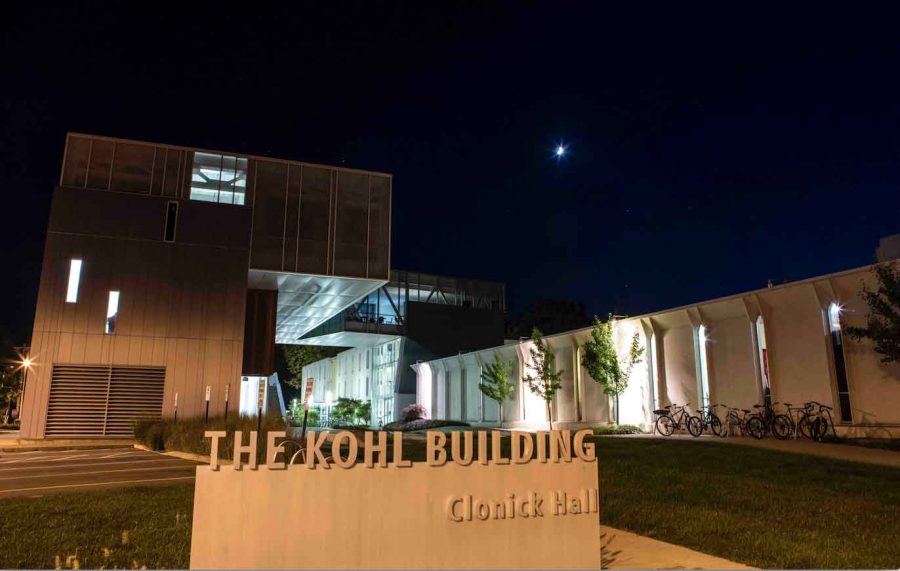Fundraising Campaign Rakes in $318 Million
Lights shine on the Kohl Building, which was partially funded by money raised in the Oberlin Illuminate fundraising campaign, Thursday night. The College officially concluded the campaign June 30.
October 7, 2016
Trustees, donors and volunteers will celebrate the end of Oberlin Illuminate, the most successful fundraising campaign in the College’s history, at a dinner tonight. Over the course of the seven-year campaign, the College raised almost $318 million, blowing past the original $250 million goal. The campaign officially ended June 30.
To the two trustee co-chairs for Oberlin Illu- minate, Pat Shanks and Chesley Maddox-Dorsey, the campaign was a much-welcomed yet unan- ticipated success.
“When we began campaign planning in 2009, during the Great Recession, no one thought this result would have been possible,” they wrote in an email to the Review.
President Marvin Krislov agreed, noting that faculty, staff, alumni, parents and friends of the College all played a part.
“We’re really pleased with the results,” Krislov said. “Thirty-five thousand donors ended up contributing, 71 donors made a gift of $1 million or more, which is 58 percent of the campaign. The trustees gave a little over a quarter of the total.”
Krislov said that the ending of the campaign “absolutely” played a role in his decision to leave, noting that Oberlin Illuminate and the Strategic Plan were two of his most important projects as President.
“It’s good for institutions to have strong leadership and also to have orderly transitions,” he added. “I’m really proud of everything that we’ve been able to do. I’m going to continue to work really hard, and Oberlin will always be part of me.”
According to Vice President for Development and Alumni Affairs Bill Barlow, about $145 million of the $318 million is earmarked for the endowment. Much of the rest has gone to capital projects, such as renovations of the Apollo Theatre and the Allen Memorial Art Museum and the construction of the Kohl Building. Some of the funding has already gone into the operating budget to support programs such as the Center for Learning, Education and Research in the Sciences and the Center for Languages and Culture.
While the campaign surpassed the overall fundraising goal, it did not meet all of its more specific goals. The College received $75 million for financial aid, falling short of its original goal of $90 million. However, Krislov pointed out that much of the money raised is unrestricted, allowing the College to spend it on core priorities such as financial aid. For Krislov, the struggle to raise more money continues.
“We still need to raise a lot of money on an ongoing basis, and one of the things we’re focused on this year is really raising money for financial aid and scholarships, which is really the highest priority,” he said, adding that the College is also currently fundraising for the Health and Wellness Center and Hall Auditorium.
Barlow stated that he felt alumni in particular “stepped up” for this campaign, with Barlow observing many alumni giving gifts larger than they originally expected.
“This campaign was successful because thousands and thousands of people do believe in Oberlin, what it stands for, and want to make sure that it can do for others what the institution was able to do for them,” Barlow said.
Krislov added that he believes the key factor to the campaign’s success was effectively communicating the seriousness of the College’s financial need to donors.
“Part of it is educating people about the financial challenges of institutions like Oberlin — that to thrive, we really need a lot of support from donors,” Krislov said. “Some of our peer schools have very large endowments and smaller student bodies than we do.”
Barlow noted that peer schools, such as Amherst College, Williams College, Vassar College and Wesleyan University, raised more money than Oberlin during the same time period.
“Oberlin’s history, in terms of its commitment to people who are going out and maybe not living their lives in the most lucrative professions [impacts] our ability to raise as much as some our peer institutions, which frankly have sent more people to financial services and other places where they can amass greater wealth,” Barlow said.
Not all of the $318 million is currently sitting in the College’s bank account. According to Barlow, a large segment of the money comes from multi-year commitments, not lump sum payments.
The College has secured $80 million in promises from donors 70 and older to include the College in their wills. Since money received over the course of several decades is worth less than money received today, only $40 million of that sum counts toward the campaign’s total.
Planning for the next fundraising campaign will likely begin within the next two to three years once a new president settles in at Cox Administrative Building.





















